From The CRPG Addict
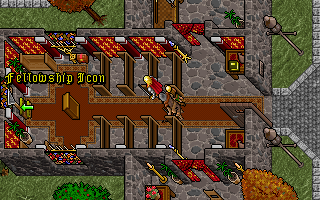 |
| The Fellowship has managed to infiltrate Britannia with the closest thing this world has ever had to a church. |
For a game that gets really good, Ultima VII does not start promising. Particularly disappointing was the character creation process. This is the first Ultima since II not to allow any importing of characters. Character creation had of course reached its peak in Ultima IV, where the gypsy’s questions sorted you into one of eight classes and determined your starting attributes. Ultima V and VI lowered the number of classes to functionally three (fighter, bard, and mage, with the “Avatar” class a kind of synthesis of the three) but still let you go through the gypsy exercise, the specifics of which were retconned in VI. You could choose a female Avatar for the first time, and select from about half a dozen portraits whether male or female.
Ultima VII offers the fewest options of any of the games in the series. You can only type your name and select your sex, and there’s only one character portrait for each sex. And they’re both horrible–although the male Avatar does fit with the canonical portrait ORIGIN has been pushing on players since VI, including the two Worlds of Ultima spin-offs.
I briefly considered playing a female character, which I never do for the Ultima series, but I didn’t feel like looking at her portrait for dozens of hours, either. Why did ORIGIN reduce character customization? Was it just a matter of not wanting to spend the programming time to vary the portrait that shows up in dialogue? That’s a lazy approach for a company that did such a meticulous job with everything else.
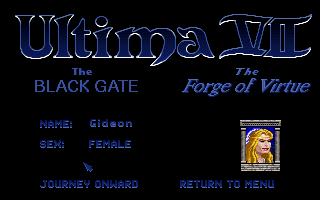 |
| The female Avatar has Evil Resting Face. |
I sighed and chose the male portrait, naming him “Gideon”–my official alter-ego for any character I’m really invested in.
The opening moments beyond character creation are as chaotic as anything, especially for a new player. We start with a street scene in what turns out to be Trinsic. Two characters, one of them white-haired, are standing outside a stable and trading laments over some horrid event. Suddenly, the red moongate appears and spits the Avatar onto a paved (or at least cobblestoned) street with gas lamps–the first sign that Britannia isn’t the same Dark Age kingdom we last saw.
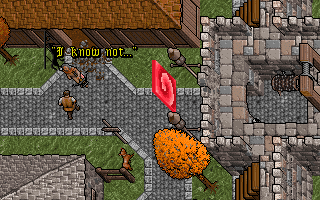 |
| Where were moongates that open inside the city in the last couple of games?! |
The white-haired, bearded man turns out to be Iolo, who immediately recognizes the Avatar despite not having seen him in–as he quickly reveals–200 years. Iolo and Dupre and Lord British are still alive because they originally came from Earth. No explanation is given for the longevity of the rest of the Avatar’s companions. The time jump isn’t really necessary at all, except perhaps to explain why Britannia looks more Colonial than Medieval. I don’t buy the rapidity at which the Avatar returns to his friendship with people who haven’t seen him in two centuries. I had some good friends when I was in my 20s, but I doubt I’d recognize them if I lived to be 220, nor would I attach a lot of significance to our friendship given all the other people I would have met, and all the other things I would have done, in that intervening time.
I soon learn that “something ghastly” has happened in the stables. The other person is introduced as a stablehand named Petre. I am encouraged to go and look in the stables for myself, which sounds fine to me. All I really want to do at this point is turn off the damned music. But I don’t have time to do even that, let alone enter the stables, because there’s a sudden earthquake. Iolo pipes up and suggests that Lord British might know the reason behind it. The tremor, we later find out, is caused by the events of the Forge of Virtue expansion. But, damn–did it have to happen immediately? This is like modern Elder Scrolls and Fallout games where you buy the expansions and you get 8 pop-up messages the moment the game starts telling you where to go to start the DLC missions. Could they maybe be spaced out a little?
Recovering from that, I’m about to move when suddenly the mayor of Trinsic comes hustling in from stage left. Iolo introduces him as Finnigan. Finnigan is doubtful that I’m the Avatar at first, but he ultimately relents and asks me to solve the murder that has just occurred. At this point, all my Avatar wants is a quite room and an Advil, but he gamely accepts the quest, which immediately prompts a dialogue with Petre. When can I finally turn off the @#$&ing music!? Not only do I find it repetitive and annoying, I suspect it’s responsible for the fact that the dialogue keeps freezing.
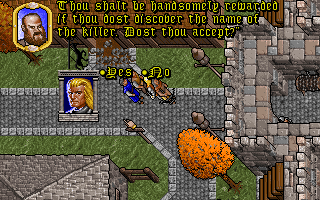 |
| It’s a choice, but “no” just gets you trapped in town. |
It becomes clear that in fact two people have been murdered: someone named Christopher and a gargoyle named Inamo. After some more dialogue that I miss because the game froze and implemented all my clicks when it un-froze, I finally have control. I turn off the music and save the game, and immediately things start to improve. The first thing I notice is that, with the music gone, there are background noises. I’m a big fan of games that use sound effectively to create a sense of immersion, and ambient sounds are a big part of that. We have a couple of different types of birds chirping in the distance and waves crashing on the shore to the east (Trinsic is a coastal city).
As we discussed last time, the interface has gone almost all-mouse, something I find maddening given that Ultima pioneered the efficient use of the keyboard. You right-click and hold to walk, with walking speed increasing the further you get from the Avatar. You left-click to do almost anything else. Single-left-clicking looks; double-left-clicking talks and uses; clicking and dragging moves and picks up.
 |
| The Avatar’s attributes. |
There are still a couple of useful keyboard shortcuts: “I” to open inventories, “C” to enter and exit combat mode, “S” to save and load, ESC to close windows, and the venerable “Z” to bring up character statistics. It’s here that I found my Avatar has 18 in strength, dexterity, and intelligence. There’s a “combat” statistics for the first time, and I’ve started the game at Level 3 with the ability to train 3 attributes. Iolo is also Level 3 and has about the same statistics.
The inventory has been much discussed. You get an image of your character with lines pointing to slots for left and right hands, legs, armor, boots, gauntlets, rings, helm, neck, missile weapon, cape, and backpack. Ultima VII: Part Two will turn this into a proper “paper doll” screen where the character image itself changes to reflect what’s equipped. For now, you click and drag things in and out of those slots. The Avatar has started with leather boots, leather leggings, leather armor, a dagger, and a backpack.
 |
| The Avatar’s inventory and pack. |
It’s the backpack where things get crazy. You can stuff a lot of things into it (as well as bags and other containers), and the little icons freely overlap. Finding a small object like a key in a backpack full of torches, reagents, documents, and other objects is at least as hard as it would be to find a real key in a real stuffed backpack. Even though it’s been almost 15 years, I remember that the last time I played, I organized items strictly by character–the Avatar has all the quest items; Iolo has all the food, and so forth–so I wouldn’t go crazy.
So far, it’s not so bad. The Avatar has started with a map, three lockpicks, a torch, 10 gold pieces, a cup, an apple, a bottle of wine, and a bread roll. I don’t think the cup serves any use at all; although a lot of items can be used together in this game, pouring the wine into the cup doesn’t seem to be one of the options.
All right. Time to explore dialogue. I double-click on Iolo and get six options: NAME, JOB, TRINSIC, STABLES, LEAVE, and BYE. These still aren’t really “dialogue options”; they’re just keywords. And I frankly preferred it when I had to type them myself, then watch for the response to see what other keywords I might use. Now, the keywords just spawn automatically in response to the dialogue. When Iolo tells me that his JOB is adventuring with the Avatar, I get AVATAR as an option. Clicking my way through them all, I learn that Shamino has a girlfriend who works at the Royal Theater in Britain and Dupre, who was recently knighted, is probably in Jhelom. (Have I been knighted? If not, why the hell not?!) Britain has grown to encompass Paws and the castle and dominates the east coast. Lord British will probably want to see me.
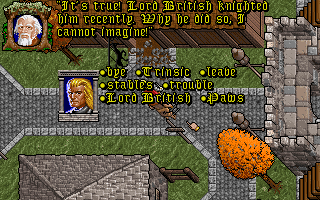 |
| Dialogue options with Iolo. |
Petre has wandered off somewhere, so I finally enter the stable. This is accomplished via a “remove the roof” interface that I believe was pioneered by Charles Dougherty in either Questron II or Legacy of the Ancients. (I wonder if ORIGIN licensed the “look and feel” of this game element from Dougherty.) The interesting thing about Ultima VII‘s approach is that entering one building removes the roofs of all buildings, so you can see items and people inside adjacent structures even when there’s realistically no way your characters would see into those locations.
Inside the stables is perhaps the most gruesome scene in any RPG so far in my chronology. (Well, no. I forgot about the two Elvira games.) The aforementioned Christopher is lying spread-eagle on the floor, each limb tied to an unspecified “light source,” his body hacked beyond recognition. A nearby bucket is filled with his blood. The gargoyle Inamo is in a back room, pinned to the wall with a pitchfork.
 |
| It’s cool that we’ve reached the point that such complex scenes can be graphically depicted. |
Several tools are strewn around the stables, including a rake, a shovel, another pitchfork, and a pair of tongs. A key lies next to Christopher’s body, and near Inamo is a sack with some bread, a torch, and a few gold pieces. Footprints are all over the dirt floor and head out the rear door. As my character investigates, I’m conscious of how much authentic role-playing I’m now doing. I mean, I already know basically where the plot is going, but I still take the time to go over everything in the stables. I move objects to makes sure nothing is underneath them. I click on things I’m not sure about to get their names. I investigate, realizing as I do so that this is one of the few RPGs up until this point to offer a level of graphical complexity and object interactivity detailed enough to make such an “investigation” possible. This is the future of role-playing in RPGs, I think. Sure, it’s not bad to have dialogue and encounter “options” that let you maintain a consistent characterization or morality, but when the very interface of the game allows you to make decisions consistent with your character, you have something special. Unfortunately, Ultima VII will not only be one of the first games to support this kind of gameplay but also one of the last.
Petre the stablehand wanders in said rear door. He says he’s the one who discovered the bodies. Inamo was apparently his assistant, and lived in the little back room. (Wingless gargoyles, I recall, are less intelligent than their winged brethren and used mostly for manual labor.) Christopher was a blacksmith who made shoes for the horses. Petre assumes the murderer was after Christopher (a logical guess given that his body was the one posed) and that Inamo was just in the wrong place at the wrong time.
We follow the footsteps out back and around the corner, where we soon come to the city gate. The gate is down and a guard patrols the room with the winch. His name is Johnson, and he says when he arrived for his shift, he found the previous guard, Gilberto, unconscious on the ground. This suggests the murderer made his escape through this gate, knocking out poor Gilberto on the way. I’d like to leave the same way and scout the outskirts, but apparently I need a password to leave the city (the manual alludes to this) and I don’t have it. He suggests I ask Finnigan. I do climb up to the city walls and see the docks just beyond the gate. I have to wonder if the murderer didn’t flee via boat or ship.
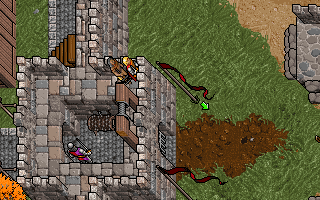 |
| No clues this way. |
Finnigan has taken off, so I settle in for a systematic exploration of Trinsic’s streets, starting by heading right out of the stables. I note that double-clicking on the street signs gives me street names, and I’m pleased to find that I can still read the runic writing without a guide. The stable is on Strand. Slightly to the west, we come to (in non-runic writing) the Avenue of the Fellowship and, right in front of us, the Fellowship hall. Might as well get it out of the way. I take a deep breath and enter.
I’m a little concerned, on a role-playing level, that the Avatar technically hasn’t been exposed to the Book of the Fellowship and thus has no reason to be cautious in his exploration of their hall. This concern is lifted when I find a Book of the Fellowship on a table right in the entryway. I imagine the Avatar reading it, asking Iolo, “What the hell?”, and getting a shrug.
The only person in the hall is a woman named Ellen, who says she runs the branch with her husband, Klog. She goes through the Fellowship philosophy and suggests that I see Batlin at the Fellowship headquarters in Britain to join. She claims to know nothing of the murder, having been home with Klog all night. I resist the urge to ransack the Fellowship hall and move on.
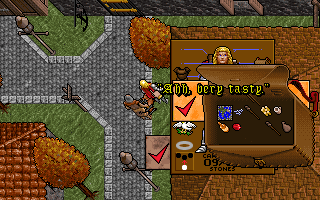 |
| Hand-feeding my characters out of the backpack. |
The Avatar complains about being hungry as we leave, so I feed him some bread. This is one of the legendary annoyances of the game. Characters have to be hand-fed throughout the game even though it’s trivially easy to find food–one of several examples of a game element created for want of a true purpose.
Up the road is the shipwright, Gargan, who offers deeds and sextants, neither of which I can afford. The notepad comes out and the “to do” list begins. Gargan has nothing to offer on the murder.
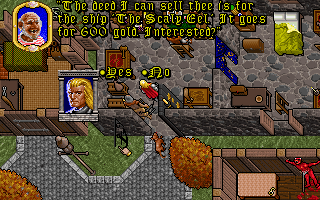 |
| I was going to object to the name of the ship, but apparently some eels have scales. |
I note that his house is filled with chests and containers. This is going to be true of a lot of houses in the game. Ultima VI was the first game in which the Avatar had an incentive to steal liberally from such containers, but this game is the first with no karma consequences. Instead of waiting until I have 80 gold pieces to buy a sextant, I can just remove one–and a gold bar besides!–from the pack in Gargan’s bedroom. You can steal things right in front of the occupants–clean out entire stores while the owners stand mute in the center of the room–with no consequences. Well–almost none. Eventually, Iolo starts making some alarmed remarks.
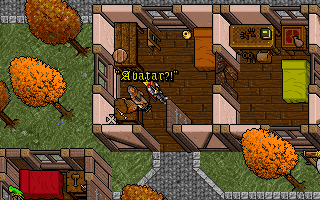 |
| Stop complaining about how hungry you are, and I won’t have to steal a roast. |
Heck, even the damned Guardian has something to say about it:
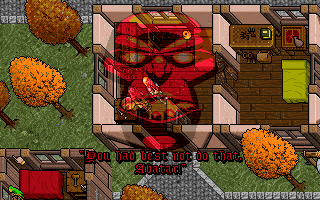 |
| Really? Burglary is where you draw the line? |
And I think maybe Iolo and your other companions leave you if you steal enough. The neat thing is that there’s a real incentive to steal. You start the game broke, and the nature of your mission doesn’t leave a lot of time for extensive wealth-gathering. But I’m going to stick to my tradition of taking my role as the Avatar seriously. I’ll do it the hard way. The sextant and gold bar stay in Gargan’s case.
I think you get the idea, so we’ll speed things up from here:
- A young woman named Caroline is on the streets recruiting for the Fellowship. She says that they have their meetings at 21:00. It turns out that Christopher was a Fellowship member.
- There’s a two-story house on the west side of town with a parrot on the first floor. No one tells me that it’s Christopher’s house, but the key we found with his body opens a locked chest on the second floor. The chest has a Fellowship medallion, 100 gold pieces, and a terse note that says, “Thou hast received payment. Make the delivery tonight.” I take the gold and note.
- Markus the trainer runs a store south of Christopher’s house. He offers to train in combat skill. I decline, not having enough money, and forgetting how training works in this game. I’ll revisit it later.
- A guy named Dell runs an armory in the southwest part of town. We do find a secret lever that opens a back room stuffed with weapons and armor, but again I decline to steal. I spend 50 gold pieces on a sword to replace my dagger.
- In the far southwest part of town, we find the healer. Gilberto is lurking around his shop with a bandage on his head. He didn’t see his attacker, but he did note that The Crown Jewel was at the dock at the beginning of his shift and gone when he woke up from his concussion. He believes it was sailing for Britain.
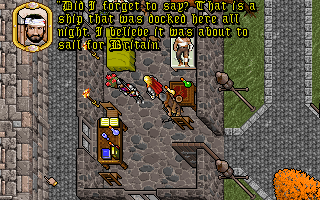 |
| Everything seems to be channeling me towards Britain. |
- The healer has a copy of The Apothecary’s Desk Reference, which reminds me of the standard Ultima potion colors. Black is invisibility, blue is sleep, orange awakens, purple conveys magic protection, white is light, yellow heals, green poisons, and red cures poison. I think I already had that memorized.
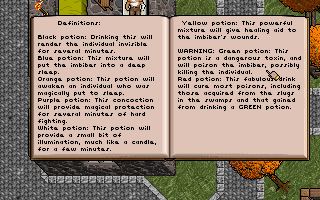 |
| Visitors from the NetHack universe are suspicious. |
- The pub and inn is called the Honorable Hound. The owner and server, Apollonia, openly flirts with me. I buy a bunch of loaves of bread. The inn’s register shows that four people have stayed there recently: Walter of Britain, Jaffe of Yew, Jaana, and Atans of Serpent’s Hold. I suppose the murderers probably didn’t register, but you never know. We spend a night in the inn at the end of all of this.
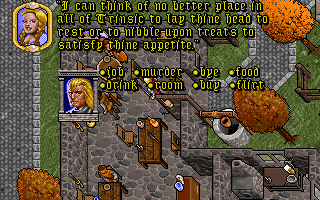 |
| There are so few role-playing moments in which “murder” and “flirt” are equally valid dialogue options. |
- I find Finnigan at City Hall in the center of town. He relates that he’s been mayor for three years. The Rune of Honor, which used to sit on a pedestal in the center of town, was stolen years ago by someone claiming to be the Avatar. It somehow found its way to the Royal Museum in Britain. Finnigan thinks this is symbolic somehow. The most important information from Finnigan is that he was present in Britain four years ago for a ritualistic murder with similar characteristics.
- Finnigan’s office is hidden behind a couple of secret doors. I find them but don’t find anything incriminating in the office.
 |
| This game is a bit odd in that it doesn’t hide secret areas; it just hides the means to access them. |
At 21:00, I peek in on the Fellowship meeting. It consists of Klug shouting the elements of the Triad of Inner Strength while the members shout things like “I believe!” and “I am worthy!” In between, Klug runs around lighting candles and occasionally genuflecting to the Fellowship icon behind the lectern.
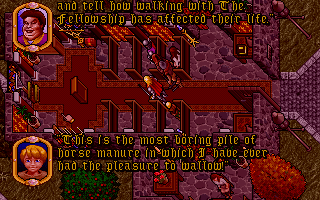 |
| Spark is unmoved by the testimony of Fellowship members. |
The Guardian’s face appears to taunt me as I enter Christopher’s workshop on the south end of town. A boy named Spark–Christopher’s son, which no one bothered to mention–is clutching a sling and running around frantically. He’s supposedly fourteen, but his portrait makes him look about six. Spark tell us that his mother died a long time ago, so now he’s an orphan. The Fellowship had been harassing his father lately, and a week ago Christopher and Klog had gotten into an argument. Christopher had been making something for the Fellowship–something probably stored somewhere in the smithy. Either Christopher was a bit disorganized, or someone has recently tossed the smithy.
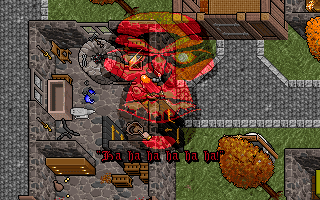 |
| Dick. |
Now that I know Christopher had a son, I feel bad about looting the gold. But Spark offers to give it to me for investigating his father’s murder. He says that he woke up from a nightmare the previous night and went looking for his father, and saw a wingless gargoyle (not Inamo) and a man with a hook for a hand hanging around the stables. He begs to join the party, and I agree. He comes with leather armor and a sling. Honestly, how were the first words out of Iolo’s or Petre’s mouths not, “Christopher has a kid. We’d better go see if he’s okay”?
 |
| I don’t know when Iolo started calling me “milord,” but I confess I don’t hate it. |
Where Christopher is dead and his son is part of the party, I don’t mind taking things from the smithy. We loot about a dozen gold pieces and some clothing items. I try to make a sword by putting a sword blank on the firepit and operating the bellows, but I can’t get the sequence right. I think it’s possible. I don’t find whatever Christopher was making for the Fellowship, unless it was pants or sword blanks.
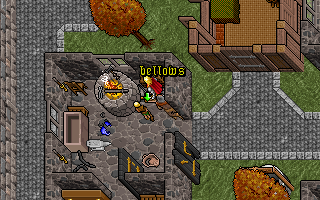 |
| Spark, you must have seen your dad do this before. |
My time in Trinsic closes with a return visit to Finnigan, who questions me on all I’ve learned and pays me 100 gold for what I’ve uncovered so far. He puts me through a copy protection exercise before giving me the password to the gates of Trinsic: BLACKBIRD. All signs point to visiting Britain next. We head outside. I find nothing at the docks except the fact (which I’d forgotten) that the developers managed to animate waves crashing on the shore for the first time in an RPG.
 |
| Another first for the Ultima series. |
Continuing a theme started in Ultima V, the developers do a good job making Trinsic feel like a real place. Each resident keeps a schedule, including going to work in the morning, eating or stopping by the Honorable Hound for an evening meal, going to the Fellowship meeting (if a member), and tucking into bed at night. Every NPC has a house with personal belongings. When it gets dark, they light candles in their houses. During the day, they open shutters with comments to themselves like “Too nice a day for these to be closed!” They have brief conversations when they encounter each other. A dog and a cat roam the streets.
This is all admirable, but the problem of course is that this simulation has come so far that we can no longer regard the NPCs and buildings we see as a representative sample of the real number of NPCs in town. They’re clearly the entire population. The fabled city of Trinsic houses 10 people. By modeling daily life in such a realistic way, the developers call attention to the lack of realism inherent in population size. We notice the same problem even in modern games.
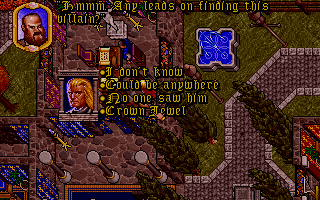 |
| Finnigan won’t let me leave town until I relate what I’ve learned. |
I’m hard-wired to create typologies out of everything, and this is something that needs a typology. Very few games in the 2000s adopt the “old school” model of towns-as-abstractions, which is most obvious in “menu towns” but also exists in games like Ultima II, where the geography of each city is just the broadest lines with the most important places (e.g., shops but no houses). BioWare has adopted what we might call the “matte background” model where the parts of the game that you can explore are just the most important parts, but the graphics suggest unending blocks of additional houses and buildings in the background. They populate the streets with a dozen generic NPCs to every important NPC, cleverly annotating the difference with sharpness of color and other indicators.
Another model for which we need a name is the Assassin’s Creed/Grand Theft Auto approach where there is a realistic number of buildings throughout the geography, including houses. You just can’t go into most of them; it would take far too much programming time to give them all interiors. The streets are also teeming with generic NPCs with basic AI. It’s far more realistic than, say, one of the cities in Skyrim, but also a little disappointing when there are so many doors you can’t open.
The Elder Scrolls follows the Ultima VII model. The developers’ philosophy is that you should not only be able to enter every building that you see but also find clothes in the closets and forks on the table. This comes with Ultima VII‘s drawbacks. Which model do you prefer, and can you think of a better approach (or one I didn’t mention at all)?
Time so far: 3 hours
*****
Potential bad news on Planet’s Edge. I’m running into a bug where if I try to beam down to Rana Prime, the game not only freezes but somehow corrupts the files so that I have to fully reinstall the game, start it, create a new save, and then load an old saved game to get my former party back. But then it corrupts again the moment I try to visit Rana Prime. No one else seems to be reporting the same issue, so I’m not sure what to make of it. Rana Prime does seem necessary to finish the game. I’ll keep playing with it; ideas appreciated.
Original URL: http://crpgaddict.blogspot.com/2020/03/the-black-gate-csi-effect.html
